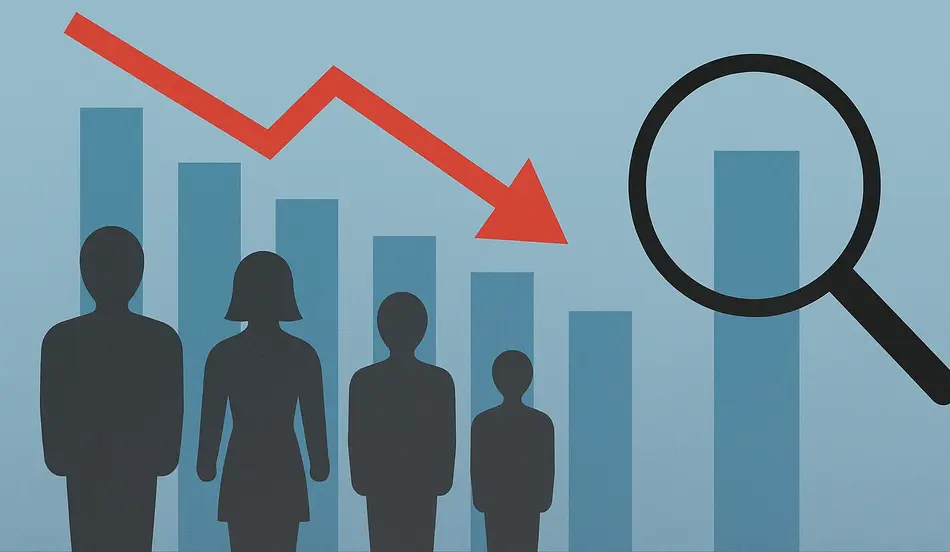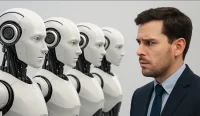The U.S. economy continues to flash mixed signals. Headlines trumpet historically low unemployment rates, steady consumer spending, and cautious optimism about interest rate cuts. Yet beneath the surface lies a troubling paradox: America’s labor force is shrinking.
For the first time since 2011, the share of Americans working or actively seeking work has registered a sustained decline. While the unemployment rate looks healthy on paper, it masks a deeper problem—millions of Americans are dropping out of the workforce entirely. This hidden weakness could undercut productivity, tax revenues, and long-term growth, while also reshaping how employers recruit talent.
Table of Contents
What the Numbers Reveal
- Labor Force Participation Rate: After peaking at around 67% in the late 1990s, the labor force participation rate has steadily declined. Today, it sits just above 62%, and the latest data shows several consecutive monthly drops—the first such sustained downturn in over a decade.
- Unemployment vs. Participation: A low unemployment rate (hovering around 4%) suggests a strong job market. But this measure only counts people actively looking for work. When millions stop searching, they vanish from the unemployment figures, giving the illusion of stability while hiding structural weaknesses.
- Demographic Shifts: The share of Americans over 65 is growing rapidly, contributing to retirements. Yet troublingly, younger groups—especially men aged 25–54 and women aged 25–44—are also exiting the labor market in significant numbers.
Why Workers Are Leaving
1. Aging Population and Retirements
The baby boomer generation is retiring in massive waves. Many are choosing early retirement due to rising home equity, stock market gains, or simply burnout after the pandemic. While some older workers are staying longer, the net effect is a thinning workforce.
2. Childcare and Family Pressures
The cost and availability of childcare remain major barriers, pushing many women out of the workforce. Pandemic-era flexibility—like remote work—helped many parents stay employed. But as companies return to stricter office requirements, mothers in particular are exiting jobs in record numbers.
3. Health and Disability
Chronic health conditions, long COVID, and rising disability claims are reducing participation among prime-age workers. For many, poor health or caregiving responsibilities for family members limit their ability to hold full-time employment.
4. Discouragement and Skills Gap
Some workers are discouraged by repeated job rejections or find that their skills no longer match employer demand. Rapid technological adoption, including AI, is accelerating this mismatch. Workers without digital or technical skills often exit the job market entirely rather than attempt a difficult reskilling process.
The Hidden Risks of a Shrinking Workforce
Economic Growth at Risk
A smaller workforce means fewer people producing goods and services. Over time, this slows GDP growth and diminishes America’s competitive edge globally. Productivity gains from technology can help, but they rarely fully offset a declining labor supply.
Fiscal Strain
With fewer workers, the government collects less in payroll and income taxes—just as spending pressures from Social Security and Medicare soar. The mismatch between tax revenue and entitlement obligations could intensify fiscal strains in the coming decades.
Employer Challenges
Employers face tighter labor pools, raising competition for talent. This could fuel wage inflation in certain sectors even if broader economic growth slows. Industries like healthcare, logistics, and education—where demand remains high—are already feeling the pinch.
Generational Consequences
Younger generations face the double bind of higher financial burdens (from supporting entitlement programs) and fewer upward mobility opportunities. If job-hopping slows and wage growth stalls, their long-term earning potential could decline.
Industries Hit Hardest
- Healthcare: Demand for nurses, aides, and caregivers continues to outstrip supply, worsened by retirements and burnout.
- Manufacturing: Skilled trades remain understaffed, with fewer young workers entering apprenticeships.
- Education: Teacher shortages persist nationwide as more educators leave than new ones entering the profession.
- Hospitality and Retail: Though jobs have returned post-pandemic, high turnover and limited interest from workers make staffing difficult.
Regional Divide
The shrinking workforce is not evenly distributed.
- Sun Belt States: Places like Texas and Florida still attract workers thanks to lower taxes and growing industries, offsetting some of the national decline.
- Rust Belt & Rural Areas: Regions with aging populations and fewer young migrants are seeing sharper drops in participation. This deepens economic divides and contributes to uneven recovery.
Possible Solutions
1. Immigration Reform
Expanding legal immigration could help replenish the workforce. Highly skilled immigrants can fill technology roles, while other visa programs can support industries like agriculture, hospitality, and healthcare.
2. Childcare and Family Support
Affordable childcare and family-friendly policies could bring more parents—especially mothers—back into the workforce. Tax credits, subsidies, and flexible scheduling are proven levers.
3. Reskilling and Education
Investments in workforce training, apprenticeships, and digital upskilling can close the mismatch between job seekers and employer needs. Public-private partnerships will be key.
Hire Talent That’s Ready to Grow
Post your job on WhatJobs and connect with candidates investing in apprenticeships, training, and digital upskilling to meet employer needs.
Post a Job Now →4. Health and Accessibility
Better healthcare access, disability accommodations, and remote options could re-engage workers sidelined by illness or physical limitations.
5. Employer Flexibility
Companies that embrace hybrid or remote models may capture talent from groups otherwise excluded by geography, health, or caregiving responsibilities.
FAQs: The Shrinking Labor Force
Q1: Why is the labor force shrinking despite low unemployment?
Because unemployment only measures those actively seeking jobs. Millions of Americans have stopped looking altogether, often due to retirement, childcare challenges, health issues, or discouragement.
Q2: How does a smaller workforce hurt the economy?
It reduces overall output, slows GDP growth, shrinks tax revenue, and increases strain on government programs like Social Security and Medicare.
Q3: Which groups are exiting the workforce the fastest?
Older Americans retiring in large numbers, mothers with young children facing childcare challenges, and workers with health limitations. Troublingly, some prime-age men and women are also withdrawing due to discouragement or skill mismatches.
Q4: What can be done to reverse this trend?
Solutions include expanding immigration, making childcare affordable, investing in reskilling programs, improving health support, and encouraging employer flexibility with remote and hybrid work.
Conclusion
The shrinking labor force is a silent crisis that threatens America’s economic strength. Low unemployment may comfort policymakers in the short term, but it masks the reality of millions of Americans who have stopped working altogether.
If left unaddressed, this trend could sap innovation, widen generational divides, and leave employers scrambling for scarce talent. Reversing the decline will require coordinated action from government, businesses, and communities alike. The question is not whether America can adapt—but whether it will act quickly enough to keep its workforce, and its promise of opportunity, alive.




